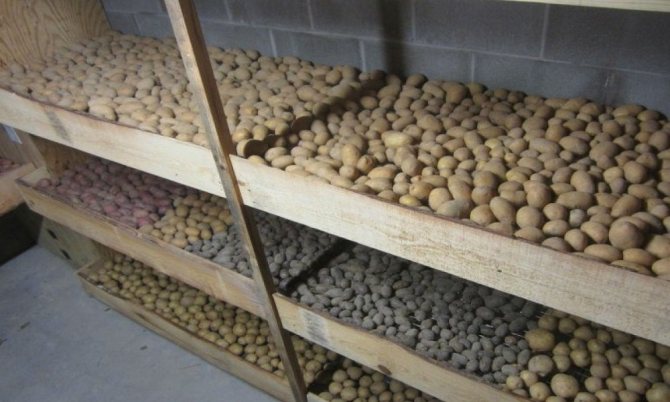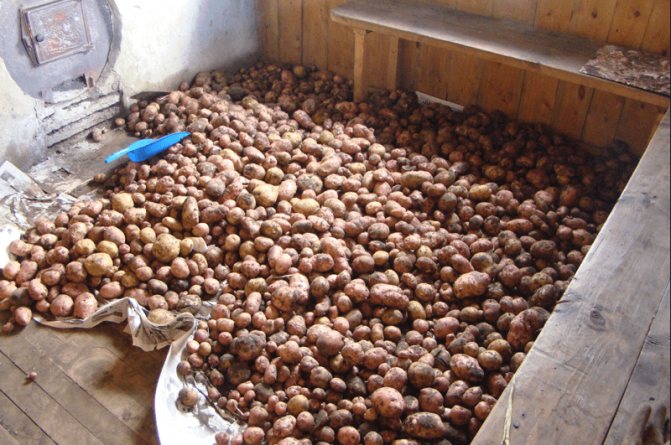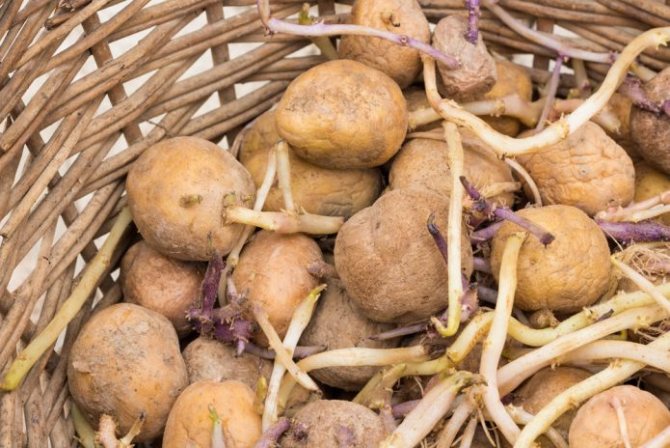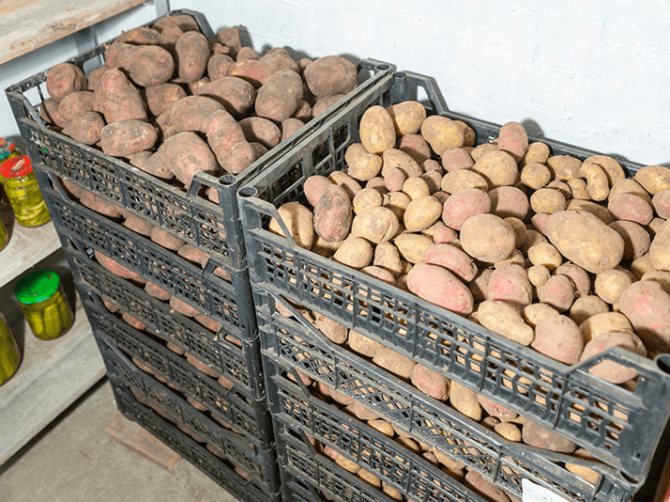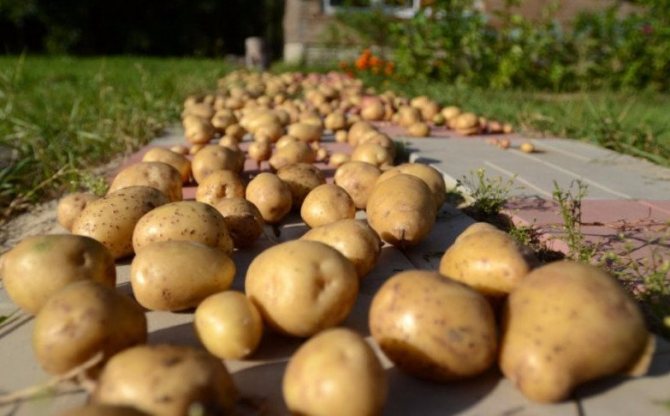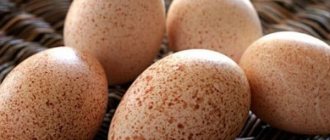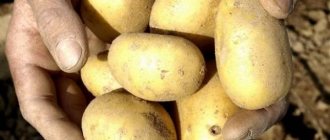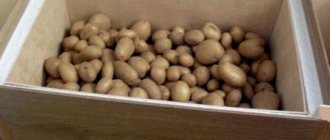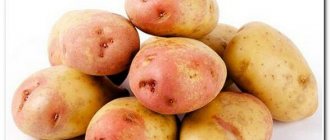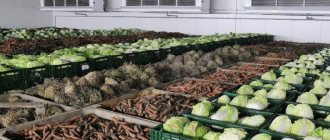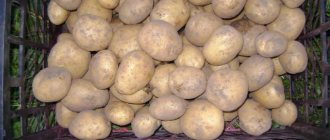At what temperature to store potatoes so that they do not deteriorate and germinate is an urgent question for the owners of cellars and basements. The following conditions are considered optimal: air temperature +2 - +3 degrees and humidity 70-80 percent. If the store is warm in winter, the potatoes will “smell the spring” and begin to sprout. When the temperature drops to zero, the starch contained in the tubers will turn into sugar. If the thermometer drops to minus, the potatoes will simply freeze and disappear. We will talk further about how to provide optimal conditions for storing potatoes in a cellar or basement.
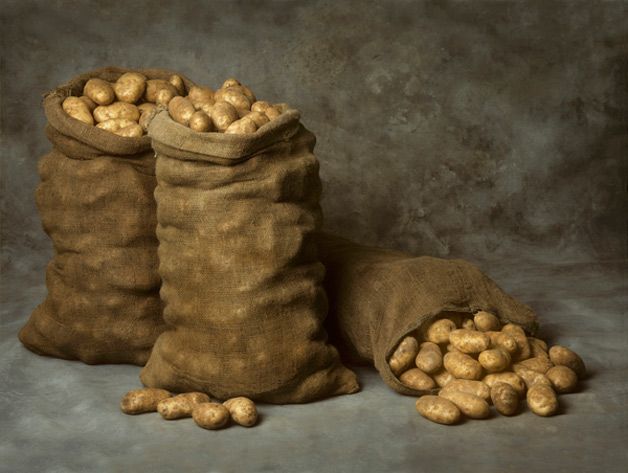
Timing of harvesting potatoes for winter storage
Growing potatoes on their own farm, gardeners often dig in bushes with young potatoes or harvest them early for daily use.
For winter storage, early collection does not guarantee its good preservation. Only well-ripened tubers should be stored, for which it is necessary to perform the following measures.
- The yield of potato tubers begins to form when the lower leaves of the tops dry out. Ripening period is approximately 3-4 weeks. During this period, the tops dry out and die off, and starch and other substances accumulate in the tubers, giving an individual taste and aroma to each variety.
- 1-2 weeks before harvesting, dry tops are mowed. Potatoes are left in the ground to ripen. The potatoes are covered with a thick coarse skin, forming dry eyes.
- They begin to dig up potatoes in dry, sunny weather, so that the tubers have time to dry out in the sun, and after processing - even some time in the shade.
- In warm regions, potatoes ripen completely in the ground, while in colder regions it is more practical to determine the time of digging by weather conditions.
- Early potato varieties are harvested in July and early August, medium ones - from August 10-15 until the end of the month. Late - in the third decade of August - the first half of September. It is impractical to store potatoes in the ground for longer: autumn rains may begin. The tubers will pick up a lot of moisture and reduce keeping quality in winter. With prolonged drought, tubers can, on the contrary, lose moisture, becoming unnecessarily soft.
Purchased potatoes for storage must be purchased of one variety. The varieties with yellow flesh are better stored. Different varieties (in appearance, pulp color) are stored in different containers. Before backfilling for storage, the potatoes must be dried in the air for 1-3 weeks, sheltering from the sun's rays so that they do not turn green. Further storage conditions are the same as for self-grown.
The best storage spaces from the experts
Every owner wants to have fresh and beautiful potatoes all year round. But for the latter to remain so, it needs to create the right storage conditions. Including the storage temperature of potatoes should be +2 degrees. One of the very first and best devices for preserving tubers in their original form is the cellar. Its history goes back to the distant past, when people discovered that vegetables are stored much better in an ordinary pit than on a protected surface of the earth.
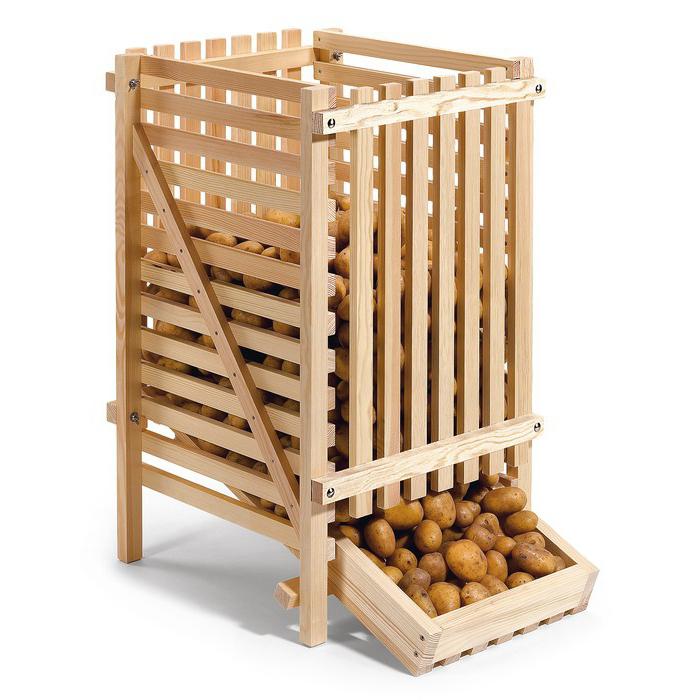

The most beloved and delicious root vegetable is quite unpretentious in care, cultivation and processing.Subject to simple requirements for storing potatoes, he will delight all family members with his presence on the table in the form of various dishes.
At what temperature to store potatoes so that they do not deteriorate and germinate is an urgent question for the owners of cellars and basements. The following conditions are considered optimal: air temperature +2 - +3 degrees and humidity 70-80 percent. If the store is warm in winter, the potatoes will “smell spring” and begin to sprout. When the temperature drops to zero, the starch contained in the tubers will turn into sugar. If the thermometer drops to minus, the potatoes will simply freeze and disappear. We will talk further about how to provide optimal conditions for storing potatoes in a cellar or basement.
At what temperature does potato freeze
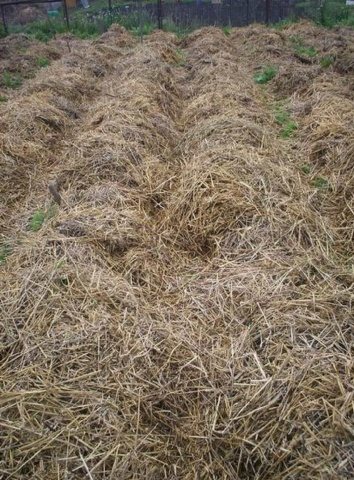

Mulch perfectly protects potatoes from freezing
So early frosts will not harm the potatoes, but when they come with the harvest, it is better to hurry up. Already at 0 ° C, the starch in the tubers begins to transform into sugars, the taste and keeping quality of root crops deteriorate.
If the potatoes are frozen in the ground, it is better to dig them up in the fall: firstly, perhaps not all tubers are hopelessly spoiled and some can be saved, and secondly, a large number of root crops in the soil in the spring will attract all pests from the surrounding areas.
Although potatoes freeze at -1.7 ° C, tubers that have been kept indoors at 0 ° C for a long time also become slightly sweet. To restore the taste of such potatoes, it is enough to hold them for 10-14 days in a darkened drawer in the kitchen.
If the tubers have been in the cold for a long time, then after defrosting they quickly become lethargic and begin to rot. Therefore, defrost them only as needed.
In addition, there are two more options for using frozen tubers:
- chop and add to the mash. Frozen potatoes contain a lot of sugar, so they are suitable for making moonshine. True, the quality and smell of the drink leaves much to be desired, it contains a lot of fusel oils, and in unrefined form it is suitable only for external use;
- eat.
Preparation and storage stages
In order to successfully preserve the potatoes grown at home for the family until the next season, it is necessary to prepare the tubers for laying after harvesting.
- The dug potatoes are sprinkled in the sun for several hours and allowed to dry. Ultraviolet rays will destroy some of the fungal-bacterial infection.
- Having shaken off the tubers from the ground, they are carefully sorted out and sorted into fractions: large for food purposes, medium for reproduction, small for fodder for poultry and livestock (if any). Sick potatoes are separated and destroyed, especially those damaged by late blight, cancer and other fungal and bacterial diseases.
- Sorted potatoes are sprayed with antifungal biological products (phytosporin, bactofit, etc.), dried in the shade, filled with containers prepared for storage and put into storage.
- To preserve more healthy potatoes, it is best to grow and store a larger variety of medium and late varieties. But during storage they do not need to be mixed, since each variety is individual in its preservation requirements.
Early varieties are not stored for a long time and already in November the tubers begin to wrinkle, lose their taste and become unsuitable for food. Early varieties are stored for propagation only.
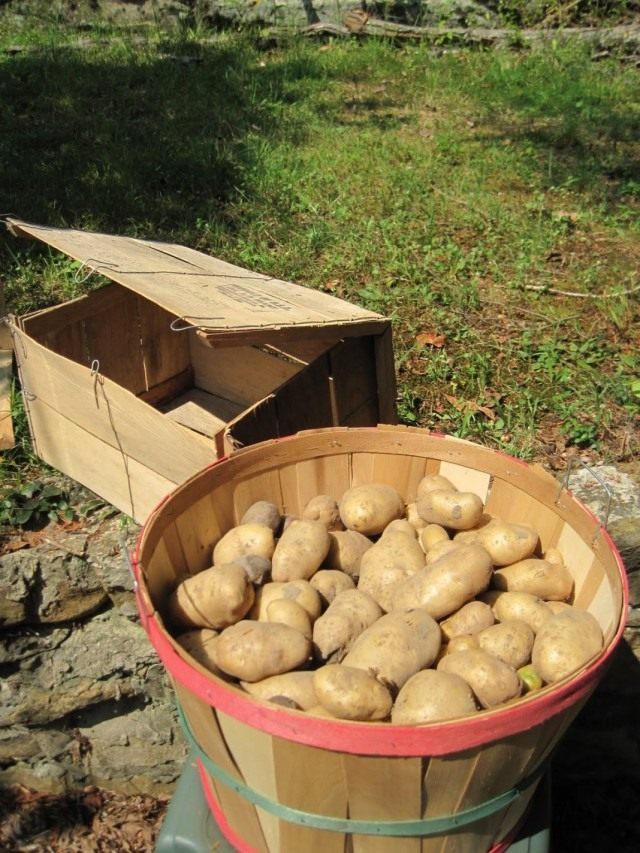

Container for storing potatoes
In order for storing potatoes not to turn into a fight against rotting, sprouting, and so on, you should properly prepare the dug crop even before laying.
The first is true to a certain extent, but the second is not entirely true. Excessive moisture is undesirable for storing potatoes, and tubers left in the ground for a long time accumulate its excess. And the stored potatoes will start to sprout quickly.Therefore, the ripe crop must be immediately removed from the ground.
The storage process itself is divided into three stages:
- Sorting and drying. These processes take about two weeks, at which time the temperature in the room is maintained at 15-17 degrees. The harvested crop is scattered in a dry room with good ventilation and no direct sunlight. At this temperature, potatoes are sorted, separating damaged tubers from healthy ones, and seed material from potatoes for food.
- Healing stage. Another 10 days will be spent on the healing of those tubers that were damaged during harvesting and transportation. At the same time, the optimal storage temperature for potatoes is 12-14 degrees with a humidity of 95 percent.
- The storage stage is the final one. Prepared potatoes are transferred to a container for storage and placed in a special room - basement, cellar, etc. The room must be ventilated, disinfected and dried beforehand.
We suggest that you familiarize yourself with: What type of fruit does cabbage have?
Freezing potatoes during storage
When storing potatoes on an unheated balcony or in a garage, there is often a danger of freezing vegetables. The condition of the tubers depends on the air temperature in the storage:
- at a temperature of 2 to 5 ° C, the potato retains its taste, at a higher temperature, it germinates prematurely, begins to wilt;
- from 0 to 1 ° C, short-term drops to -1 ° C, starch begins to split, over time a sweet taste appears;
- potatoes freeze at temperatures of -1.7 ° C and below, acquiring a pronounced sweet taste. When the temperature rises, frozen tubers begin to rot, intended for planting - they lose their germination.
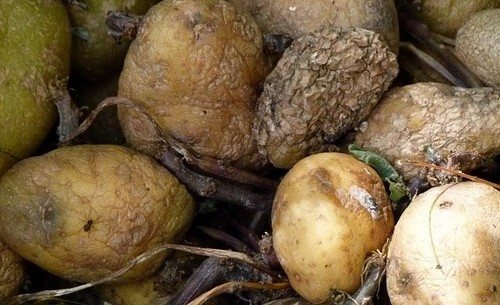

Frozen potatoes after defrosting quickly begin to rot
Both storing potatoes in the cellar and storing potatoes in the basement presuppose protecting the crop from freezing. The question of at what temperature the potatoes freeze has been discussed more than once on various Internet forums, many articles have been written about this. Any subzero temperature, or even zero, is considered negative.
At minus 1, partial freezing occurs, and at 3-4 degrees below zero, the potatoes freeze. Even if you store potatoes in a cellar, there is a chance that frosts will get there too. If the cellar or basement is not insulated, and the crop has not yet been dug out, it's time to take care of the insulation. If it is not possible to do this, then you will need to store it in specially prepared boxes.
At the same time, if the storage is located outside the house, then you can build additional protection against frost, snowfall and winds - a canopy or a roof. The escape hatch is also insulated with foam or other insulating material.
But when creating better storage conditions, you shouldn't be overly zealous. Otherwise, the temperature of the initial freezing of potatoes will smoothly grow into the temperature of its germination. And the sprouts begin to appear already at 4 degrees. Therefore, it is necessary to store potatoes in winter at a strictly defined temperature, avoiding significant changes in it.
Storage in special refrigerating chambers
Sometimes it turns out that in apartments the balcony is combined with the main living quarters, and a private house is not equipped with a basement or other similar structure. Potatoes do not even want to listen to such excuses and require proper storage space. Fortunately, the solution is quite simple - the purchase of special refrigerators, in which the optimum temperature for storing potatoes is set at 3 seconds. This equipment will be affordable only for wealthy citizens. But it's worth it, as you can solve the eternal storage problem once and for all.
The advantage of special refrigerating chambers is that not only potatoes, but also other vegetables can be stored in such devices.They do not require installation of ventilation, ventilation, special conditions for operation and repair. It is enough just to install this camera at home and switch it to a convenient temperature regime for storing potatoes.
Storage conditions for potatoes
The origin of the culture from mountainous regions with cool climates has implications for the agrometeorological responses of the culture. Climatic features, physiological environment are extremely important for the production of high yields with good quality tubers, in conditions typical for each specific site.
It is no secret that the correct climate provides a large number of tubers from the bush.
Potatoes have a fibrous root system, at best no more than 60 cm deep. As a result, the plant often cannot fully utilize nutrients and moisture within the soil profile.
It is best to plant when the soil temperature is 7-10 ° C, daytime is in the range of 18 ° C, nighttime - 12-18 ° C. The optimal soil condition for root growth is from 10 to 35 ° C, the most active development occurs at 15 -20 ° C. Conditions are similar for the development of stolons.
For the growth of foliage, from 7 to 30 ° C, the best mode is from 20 to 25 ° C. The appearance of tubers is caused by a short photoperiod and includes growth hormones. The cooler the soil temperature, from 15 to 20 ° C, the faster and more tubers are formed.
The process is favored by a low level of nitrogen and a high level of sucrose in the plant. High temperatures (35-40 ° C) reduce and actually stop the formation of tubers. Also, the long duration of the day delays the onset of tuber development.
Too high temperatures are harmful to crop growth
- At 9 ° C there is a slight elongation of the seedlings, very slow at 6 ° C.
- At temperatures below 6 ° C, development practically stops.
- Exposure of tubers to soil at 1-2 ° C for several days results in severe damage that affects the normal growth of the plant.
Potatoes prefer well-drained, fertile soil with a high organic matter content, with an acidity level of 5.0 to 5.5. As the soil becomes more alkaline, the size of the crop increases, but the incidence of scabs also increases - a condition that affects the skin but not the nutritional value of the product.
Temperatures between 12 and 18 ° C are considered the best for harvesting and processing tubers. Under cold and heat stress, when below 5 ° C and above 25 ° C, they are susceptible to disease, the risk of microbial rot.
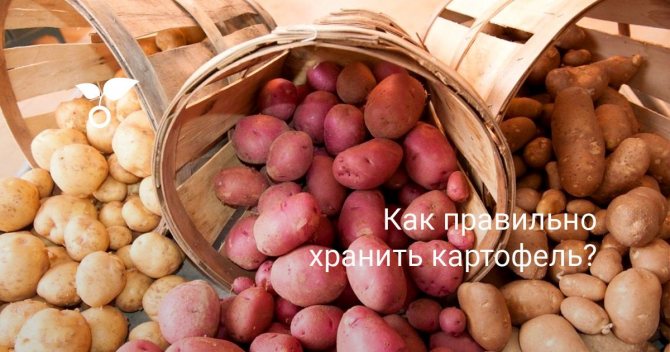

The storage area for potatoes must be suitable for the temperature conditions in order for the product to remain healthy and the natural decomposition process to slow down.
It is extremely important that it is dark, well-ventilated, for long-term storage of the seed variety, a mode of about 4 ° C is maintained.
For short-term storage, followed by cooking, an environment of 7-10 ° C is preferred.
Storage for long periods of time at temperatures below 4 ° C converts potato starch into sugar, which alters its taste and culinary qualities, it becomes bitter and is caused by an enzyme called invertase.
Once the starch is converted to sugar, it triggers a potentially dangerous chemical reaction during cooking. When baked or roasted, the sugars combine with the amino acid asparagine present in the tubers to produce the chemical acrylamide, a genotoxic carcinogen.
To maintain a low sugar content in the tubers, the culture is stored at intermediate temperatures of 8-12 ° C, although there is a risk of tuber sprouting.
We suggest that you familiarize yourself with: After which crops can you plant garlic and onions before winter
In an adequate environment in commercial warehouses, potatoes are stored for ten to twelve months. At home, the term is only a few weeks. If the tubers develop green areas containing glycoalkaloids, they must be trimmed before using the product.
Green spots on tubers should not be allowed to eat
Optimal conditions of temperature, humidity, aeration, oxidation state are the most important factors for storing potatoes. As a living organism, its quality decreases due to moisture loss and physiological decay. Deterioration is directly related to storage temperature.
To keep more potatoes healthy, the following requirements must be met.
In any type of storage, maintain the air temperature within 2 .. 4 ° С. At this temperature, the potatoes are dormant - they do not form roots and do not freeze. Lower temperatures promote the conversion of starch into sugars, while higher temperatures trigger the process of root formation.
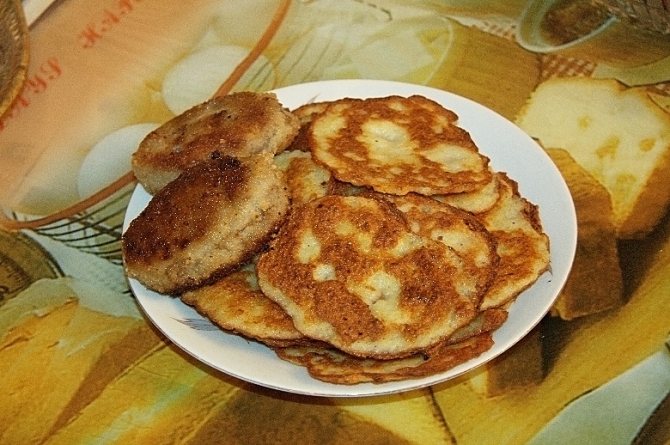

The store must have thermometers to measure the temperature, as well as the ability to take action when it changes. If the temperature rises quickly, open air vents, arrange ventilation.
The air humidity in the room where potatoes are stored should not exceed 70-85%. To determine, install a hygrometer in the room. An increase in humidity contributes to the appearance of mold fungi. The air in the room is dried or ventilation is used.
The bottom of the potato storage should be covered with sand, preferably quartz, pebbles, gravel, and other material that absorbs moisture. The bottom of the cellar and other types of storage facilities cannot be cemented, covered with linoleum, smooth slate, floorboards and other similar materials, as this accumulates moisture, which contributes to the appearance of mold and other negative processes.
Daytime and long-term artificial lighting is unacceptable in the store. Light promotes the production of poisonous solanine in potato tubers. The external manifestation of the production of solanine is the greening or dark green color of the tuber. These potatoes are not edible.
To save potatoes from winter pests and diseases, you need to carefully prepare the room and, accordingly, arrange the tubers in a convenient container.
- Isolate the storage from outside pests: mice, rats, slugs.
- Disinfect the premises from fungal and bacterial infection (burning a sulfur checker or just lumps of sulfur on a metal pallet or use other methods of disinfecting the premises).
How to prepare and store seed potatoes
In general, there are few differences, except that the future planting tubers should be “greened” at the stage of preparation (keep it in the sun for a longer time, but preferably under diffused sunlight). In other words, solanine must be produced in them, which makes them unsuitable for human consumption, but the same poisonous substance will protect potatoes from putrefactive infections, and besides, such tubers will definitely not gnaw mice.
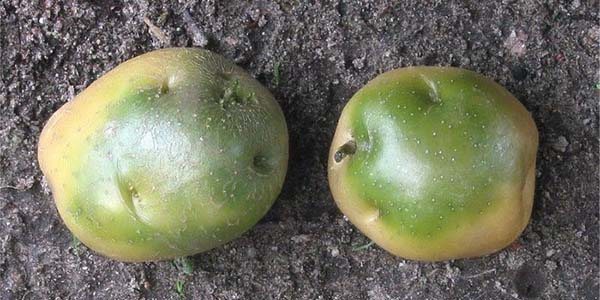

If the tubers that will be eaten are to be processed as desired, then it is recommended to sprinkle the seed. In this case, such a drug as "Maxim Dachnik" is ideal for you. Then dry thoroughly and store in a separate place.
Storage types
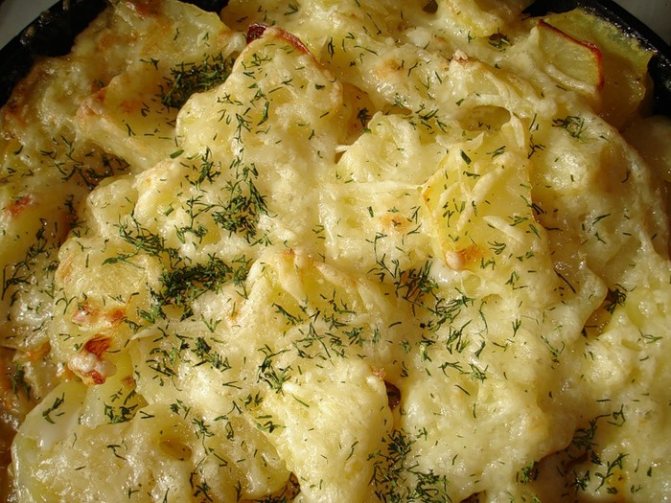

If the area allows, then they must build cellars, basements, underground, vegetable pits and other specialized storage facilities for storing products in the winter. They are equipped with special shelves, pallets are installed on the floor so that containers with products from all sides have free air exchange.
It is more difficult to provide winter storage of vegetables for urban gardeners who have a dacha with storage far away.It is necessary to fit a loggia or balcony for storage. In this case, storage in bags, nets and boxes, even covered with old fur coats, is not suitable. It is more practical to make wooden insulated boxes for storing potatoes and other vegetables. All self-made storage facilities made of wood materials must be painted to protect against external moisture.
The simplest storage on the balcony, loggia, in the corridor can be independently made in the form of a box / chest with double walls, a bottom and a lid. A thermocontainer for a household or a portable balcony cellar is more aesthetically pleasing and practical. You can buy them or make them yourself.
All types of such temporary / permanent storage have double walls, bottom and lid. The empty space between the walls (4-6 cm) in the storages is filled with any kind of insulation (dry sawdust, fine dry shavings, polystyrene, etc.). Craftsmen can equip such storages (especially not insulated ones) with electric heating with a thermostat.
If the family budget allows, you can purchase a soft portable household thermal container, or it is also called a balcony cellar. It consists of a tent fabric in the form of a double bag. Between the walls of the bags there is a heater (usually synthetic winterizer) and an electric thermostat. The balcony cellar keeps products at ambient temperatures down to -40 ° C. In the spring, the cellar is collected, cleaned / washed and stored in a secluded dry place until the next winter.
Storage in an apartment: principles
If there is no cottage or extra cellar, then you have to keep potatoes at home. The best storage space is a balcony - this place in any apartment is specially equipped for such purposes. Experienced keepers advise to do the following before storing potatoes:
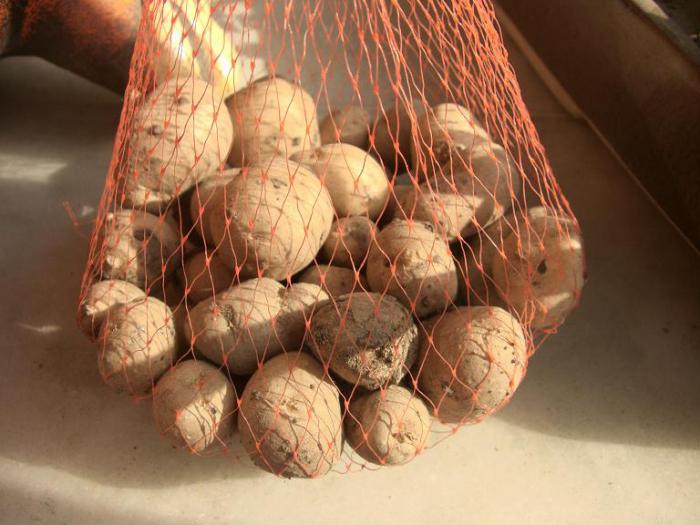

- make sure that the walls and bottom of the box are sheathed with foam;
- clean the exhaust pipes from dust and dirt, install in a box;
- depending on the size of the box, prepare blue lamps for heating in cold weather;
- check the health of the thermometer;
- clean old nets (bags are not recommended).
The storage temperature of potatoes on the balcony depends on how well and reliably the owner insulated the box and how often he will heat the latter.
Features of cooking dishes with frozen potatoes
In the old days, when they talked about difficult times, they said that they had to eat frozen potatoes. However, now peeled, neatly chopped potatoes are sold in supermarkets. Manufacturers recommend defrosting it very quickly. Plain frozen potatoes should be cooked in the same way.
Frozen tubers are easy to peel: if you hold them for a few seconds in warm water, the peel comes off like a film. Immediately after that, the potatoes, preventing them from defrosting naturally, must be dipped in boiling water or, cut into pieces, in hot vegetable oil.
Products that can neutralize an unpleasant aftertaste:
- onion;
- tomatoes and tomato paste;
- sour cream;
- sauerkraut or cabbage.
First meal
Frozen potatoes boil quickly, so it is recommended to cook them separately and add them to soups 5-10 minutes before being cooked. If the sweet taste is too pronounced, add 1-2 tablespoons of vinegar to the water when cooking potatoes. The unusual taste is practically not felt in cabbage soup with sauerkraut, pickle, borscht with tomatoes or tomato paste.
The taste of frozen potatoes is leveled in vinaigrette, salads with pickles, sauerkraut, mushrooms. For dressing, mayonnaise, mustard, unrefined vegetable oil with vinegar and spices are used.
Frozen potatoes will not puree, but small potatoes (or large ones cut into 2-3 pieces) can be baked in the oven. Peeled tubers are thrown into boiling water with vinegar, after 7-10 minutes the water is drained.The potatoes are laid out in one row on a baking sheet greased with vegetable oil, they are also greased on top, sprinkled with salt and spices, and placed in a heated oven.
Also, undercooked potatoes are cut into slices, fried and added to stews, baked in pots with meat, onions, beans and tomato sauce.
Salty baked goods
Mashed boiled potatoes with onions, buckwheat and, optionally, cracklings - a popular filling for pies and dumplings, a base for casseroles.
We suggest that you familiarize yourself with: Boiled grated beets for the winter
Approximate proportions:
- 0.5 kg of boiled mashed potatoes;
- 1 glass of buckwheat;
- 3 large onions.
Buckwheat is poured with boiling water and left for 3-4 hours to swell. Then buckwheat is mixed with potatoes, fried onions, the mass is salted and pepper. To improve the taste, add 2-3 tablespoons of cracklings. Now the mass can be used as a filling for an open pie, pouring on top with a mixture of 50 g of mayonnaise, 50 g of tomato sauce or homemade adjika, 2 eggs and 100 g of grated cheese.
If a casserole is prepared, then the top and bottom are made from potato-buckwheat mass, and fried mushrooms with onions or stewed cabbage are placed inside. The top is watered with tomato-mayonnaise filling with egg and grated cheese.
Draniki
To bake potato pancakes from frozen potatoes, you need to grind them very quickly in a blender, otherwise the potato mass will become sticky, "rubbery".
Proportions for potato pancakes:
- 2 large potatoes;
- 2 large onions;
- 1 tablespoon sour cream;
- 3-4 eggs;
- 3-5 tablespoons of flour;
- salt, pepper - to taste.
desserts
Potatoes go well with cottage cheese. Curd-potato casseroles are lush and juicy.


Proportions:
- 500 g of cottage cheese;
- 200 g boiled potatoes;
- 4 eggs;
- lemon;
- sugar to taste, optional raisins, vanilla sugar.
Cottage cheese and potatoes are ground until smooth, crushed lemon (zest and pulp), yolks and whipped whites are introduced into it.
Another use for sweet potatoes in desserts is dumplings. From 0.5 kg of mashed boiled potatoes, 2 eggs and 3-4 tablespoons of flour, knead the dough. Any fresh or frozen fruits and berries are suitable for the filling. Form balls and boil them in salted water. The prepared dumplings are sprinkled with bread crumbs fried in butter and mixed with cinnamon. When serving, pour over sour cream.
Types of containers for storing potatoes
Depending on the device of the potato storage, containers are prepared for the preservation of potatoes.
The most common are wooden boxes. Loose planks and an open top promote good air exchange. Boxes with 10-12 kg of potatoes are easy to move and, if necessary, sort the products.
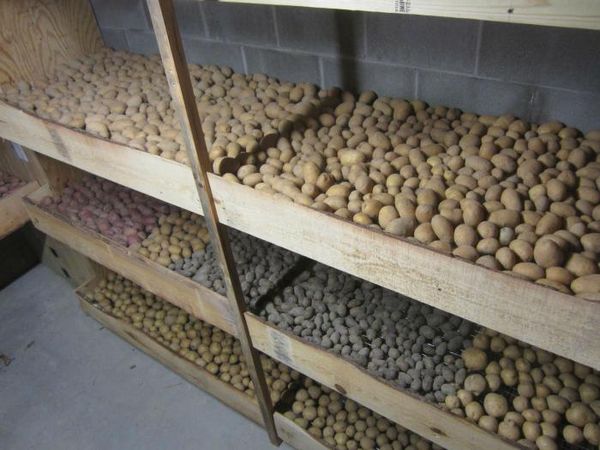

The boxes are placed on racks or shelves so that the empty space from the wall of the storage is at least 25-30 cm, from the floor to the bottom of the box / container is about 15-20 cm and from the top of the container with potatoes to the ceiling is at least 50-60 cm. Between boxes, the empty space is 10-15 cm.
It is easy to monitor the storage of potatoes in mesh bags, which, like boxes, are available for quick determination of the preservation and, if necessary, for sorting frozen, rotting, damaged and diseased tubers.
If rodents settle in storages in winter, it is better to store the products in double wire mesh containers with small cells, the bottom of which is raised above the floor. Through a single-layer mesh, the rodents take out and gnaw the sides of the potatoes, which are closely adjacent to the mesh. Some owners store potatoes in metal barrels with fine air exchange holes, closed on top with a metal mesh.
Laying in the cellar
You need to lower the potatoes into the cellar carefully, avoiding blows.
Root crops are sensitive to environmental conditions, so potatoes should be stored in specially prepared boxes or bins.Just pouring it out on the cellar floor, we risk losing a significant part of the harvest. Containers for storing potatoes should also not stand directly on the floor and touch the walls. Build wooden coasters for them, 10-15 centimeters high, or place bricks under the bottom.
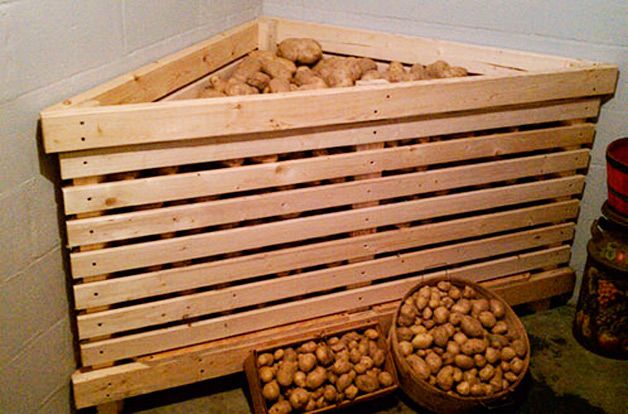

Wooden bins are ideal for storing potatoes in winter.
Bins should have additional openings in the sides for air circulation. The height of the edge of the box should not be too large so that you can bend down and calmly reach the tubers from the bottom.
The containers must be dried and disinfected before laying vegetables.
To additionally keep the potatoes from cold, cover them with felt or burlap, and sprinkle them with sawdust or straw on top. In addition to frost protection, these materials will collect excess moisture.
The root crops lying in the cellar have a breathing process, due to which moisture and carbon dioxide are released into the air. Moisture condenses on the walls and ceiling of the room, and from there it can get back onto the vegetables. To prevent this from happening, regularly ventilate the room. An additional polyethylene canopy can be built under the ceiling.
To reduce the humidity in the basement, an additional layer of lime and sand can be poured onto the floor.
It is very good to store beets in the same box with potatoes. It is advisable to sprinkle it in a thick layer over the potatoes. The beetroot cushion will protect the potatoes from the cold and absorb excess moisture. This is even better for beets.
To prevent parasites from multiplying on the tubers, leading to spoilage, you can sprinkle the potatoes with crushed chalk or ash. Craftsmen suggest that we put linen bags with natural phytoncides between potatoes: wormwood, rowan and elderberry leaves. Some gardeners place a spoon or other small silver object at the bottom of the vegetable box, or sprinkle onion skins on the tubers.
Periodically check the condition of the crop in the cellar and remove damaged or rotted tubers. It is better to put all vegetables in contact with them separately - in quarantine. If you did not reveal any signs of spoilage of vegetables, but fruit flies have started up in the vegetable store, it is likely that the lower layers of the potatoes have begun to rot. If, in addition to this, there is an unpleasant smell in the cellar, it is better to sort out all the potatoes.
Keep mice away from the cellar. Rodents love to nest in hay or sawdust.
Basic rules for storing potatoes
- The stored potatoes must be provided with ventilation.
- It is more practical to store potatoes to provide for the family in small containers (10-12-15 kg), installed on pallets or shelves, covered with any protective cover on top from freezing.
- Before storing potatoes, it is imperative to carry out a thorough bulkhead and separate diseased, damaged, green tubers from healthy ones.
- It is practical to spread a layer of beets on top of the stored potatoes. By absorbing moisture emanating from "breathing" potatoes, beets protect the latter from excess moisture, leading to a fungal infection.
- Putting a few apples in a box of stored potatoes will slow down germination.
- When storing potatoes in bulk, the embankment should not exceed 1.5 m in height. From above you need to cover the potatoes with burlap or an old blanket, blanket. This technique will reduce freezing during any weather cataclysm and preserve the possibility of free air exchange. If the floor is very cold, you can use felt to insulate it, covering it with a moisture-absorbing material on the side of the potato.
- With any type of winter storage, it is necessary to sort out the tubers 2-3 times, removing the diseased and green ones.
- Early potato varieties are usually eaten straight away.They are not subject to storage.
Early potatoes left over after November are stored as planting material. It is not used for food. Tubers shrivel, lose moisture, become tasteless.
Potatoes for planting are stored under the same conditions as food.
When storing purchased potatoes, the following varieties can be recommended: Gatchinsky, Atlant, Scarlet, Chaika, Slavyanka, Zhuravinka, Dolphin, Kolobok, Tiras, Nevsky. When stored properly, they retain their taste almost until the next harvest of early potatoes.
From early and early maturing potato varieties, Hostess, Rocco, Aurora, Pyrol are stored for up to 3 months. But, as a rule, early varieties are stored only as planting material.
Tags: freeze, what, potatoes, barn, temperature
About
«Previous post

